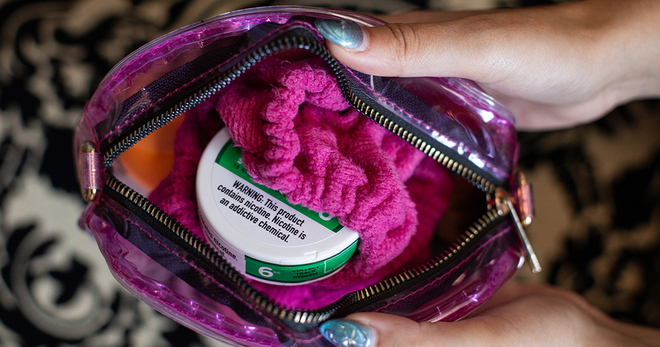Youth vaping declines during pandemic as young people report less retail and social access to products
Vaping among young people dropped amid the COVID-19 pandemic as young people reported less retail and social access to e-cigarettes, according to new Truth Initiative research that underscores the importance of restricting underage access to curb the youth vaping epidemic.
The study, which was published in American Journal of Public Health, shows that e-cigarette use decreased among young people during the COVID-19 pandemic. It found that people between the ages of 15-20 had lower odds of being a current e-cigarette user during the pandemic compared to the months immediately preceding the pandemic. The study also found that more than half of young people reported reduced access to retail environments because of COVID-19, and that e-cigarette users with reported reduced retail access had 1.51 higher odds of reporting that they were lowering their e-cigarette use. Compared to before the pandemic, young people also reported less sharing of e-cigarettes among social sources during the pandemic.
The findings highlight that underage access to e-cigarettes is a key issue in the fight against youth vaping, which persists at epidemic levels with nearly one in five high school students using e-cigarettes in 2020. Policy efforts in response to the youth e-cigarette epidemic have focused on underage access in recent years, including a 2019 law that increased the national minimum age of purchase to 21.
Rates and frequency of underage e-cigarette use fall during COVID-19 pandemic
Using a sample of 5,752 participants, researchers compared odds of e-cigarette use in the past month during the time of widespread stay-at-home directives between March – June 2020 to the pre-COVID-19 period from January – March 2020. They found that odds of e-cigarette use were significantly lower during the pandemic compared to the pre-pandemic period. Young adults ages 18-20 had 35% lower odds of current e-cigarette use and 15-17-year-olds had 28% lower odds of current e-cigarette use during the pandemic compared to the pre-pandemic period.
In addition to lower odds of vaping during the pandemic, current e-cigarette users surveyed during the pandemic reported vaping significantly fewer days per month compared to current e-cigarette users before the pandemic. Current e-cigarette users vaped for an average of 11 days in the past month during the pandemic, compared to 12.3 days among those surveyed pre-COVID-19. And nearly half (48.6%) of current e-cigarette users reported vaping less than before the COVID-19 pandemic, while about one-quarter (25.6%) reported vaping more.
Although there were no significant differences in e-cigarette use prevalence among those aged 21-24, this age group saw decreases in combustible cigarette use during the COVID-19 pandemic.
Underage access to retailers and social sources decline amid pandemic
Young people reported both reduced access to retail environments and social sharing of e-cigarettes.
More than half (57.8%) of young people reported reduced access to retail environments because of COVID-19, such as encountering changes in store hours (38.9%) or having difficulty finding consumer goods in stores (40.8%). Among e-cigarette users, those with reduced access to retail environments had 1.51 higher odds of reporting reduced e-cigarette use, suggesting that retail point-of-sale remains an important area for intervention efforts to reduce youth and young adult e-cigarette use.
Of a subset of 779 e-cigarette users interviewed during the pandemic, nearly half (45.7%) reported that they were sharing e-cigarettes less compared to before the pandemic. E-cigarette users who reported sharing e-cigarettes less during the COVID-19 pandemic had nearly twice the odds of reporting reduced frequency in using e-cigarettes, compared to those who reported no change in e-cigarette-sharing. These findings support the idea that peers and social interactions are an important source of e-cigarettes for individuals under 21.
The restrictions necessitated by COVID-19 may have created barriers to accessing e-cigarettes – through retail closures and social access – that were associated with decreased e-cigarette use that can also be effected through policy changes. “Findings support an urgency in implementing interventions designed to reduce underage access to e-cigarettes to help accelerate the downward trajectory of e-cigarette use among youth,” the authors write.
Additional Truth Initiative data show that many young people want to quit vaping. According to a Truth Initiative survey, 60% of 15- to 24-year-old current e-cigarette users surveyed want to quit vaping within the year. To support the many people who want to quit, the latest youth e-cigarette education campaign from truth®, Quit Together, tapped current e-cigarette users and TikTok influencers to broadcast their own experiences as they quit vaping, in real-time, to their huge followings across social media platforms. In Quit Together, which was featured in a Mashable story, Victoria Annunziato (aka King Victober), Tosha, and Jerry Purpdrank asked their millions of followers to join them in using This is Quitting, a first-of-its-kind, free, and anonymous text message quit vaping program from truth, created specifically for youth and young adults.
As a follow up to Quit Together, truth launched a YouTube series called Quitters that shares the stories of six people who have decided to quit vaping using This is Quitting. New episodes are released every Friday.
More in emerging tobacco products
Want support quitting? Join EX Program
By clicking JOIN, you agree to the Terms, Text Message Terms and Privacy Policy.
Msg&Data rates may apply; msgs are automated.


